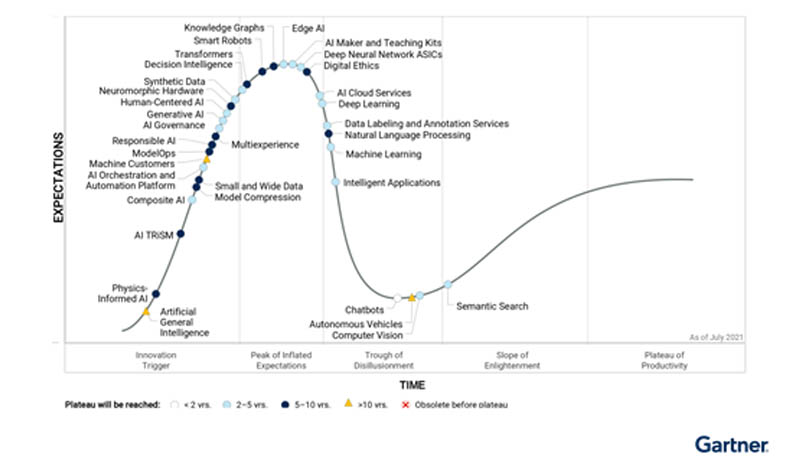
Gartner has revealed four trends in near-term AI innovation during the Hype Cycle for Artificial Intelligence, 2021. Responsible AI, small and large data methods, operationalization of AI platforms, and efficient use of data, model, and computation resources are among these developments.
“AI innovation is happening at a rapid pace, with an above-average number of technologies on the Hype Cycle reaching mainstream adoption within two to five years,” said Shubhangi Vashisth, senior principal research analyst at Gartner.
Also added, “Innovations including edge AI, computer vision, decision intelligence and machine learning are all poised to have a transformational impact on the market in coming years.”
With a high percentage of AI breakthroughs appearing on the upward-sloping Innovation Trigger, the AI industry continues in an evolutionary condition (see Figure 1). This reflects a market trend in which end customers are looking for specialised technological capabilities that are often beyond the scope of present AI technologies.
Figure 1: Hype Cycle for Artificial Intelligence, 2021

Source: Gartner (September 2021)
Here are the four trends that are driving AI innovation, according to Gartner:
“Increased trust, transparency, fairness and auditability of AI technologies continues to be of growing importance to a wide range of stakeholders,” said Svetlana Sicular, research vice president at Gartner.
Further commented, “Responsible AI helps achieve fairness, even though biases are baked into the data; gain trust, although transparency and explainability methods are evolving; and ensure regulatory compliance, while grappling with AI’s probabilistic nature.”
According to Gartner, all professionals employed for AI research and training work will be required to demonstrate proficiency in responsible AI by 2023.
Successful AI programmes are built on the foundation of data. Small and broad data techniques offer more robust analytics and AI, lessen the need on large data, and provide richer, more full situational awareness.
According to Gartner, 70 percent of enterprises will be forced to shift their focus from big to small and wide data by 2025, giving analytics more context and making AI less data hungry.
“Small data is about the application of analytical techniques that require less data but still offer useful insights, while wide data enables the analysis and synergy of a variety of data sources,” said Sicular.
“Together, these approaches enable more robust analytics and help attain a more 360-degree view of business problems.”
The importance of harnessing AI for business transformation is pushing the demand for AI platforms to be operationalized. This entails taking AI initiatives from concept to implementation so that AI solutions may be trusted to tackle enterprise-wide issues.
“Gartner research has found that only half of AI projects make it from pilot into production, and those that do take an average of nine months to do so,” said Sicular.
Also commented, “Innovations such as AI orchestration and automation platforms (AIOAPs) and model operationalization (ModelOps) are enabling reusability, scalability and governance, accelerating AI adoption and growth.”
Because of the complexity and volume of the data, models, and computational resources needed in AI deployments, AI innovation necessitates the most efficient use of these resources. Multiexperience, composite AI, generative AI, and transformers are gaining traction in the AI sector due to their capacity to tackle a variety of business challenges more quickly.
More information is available in the Gartner research “Hype Cycle for Artificial Intelligence, 2021.” The Gartner Special Report “2021 Hype Cycles: Innovating Delivery Through Trust, Growth, and Change” includes this study. The Gartner Hype Cycles for 2021 assist organisations in making innovation a core skill and in shaping and prioritising their innovation delivery methodology.